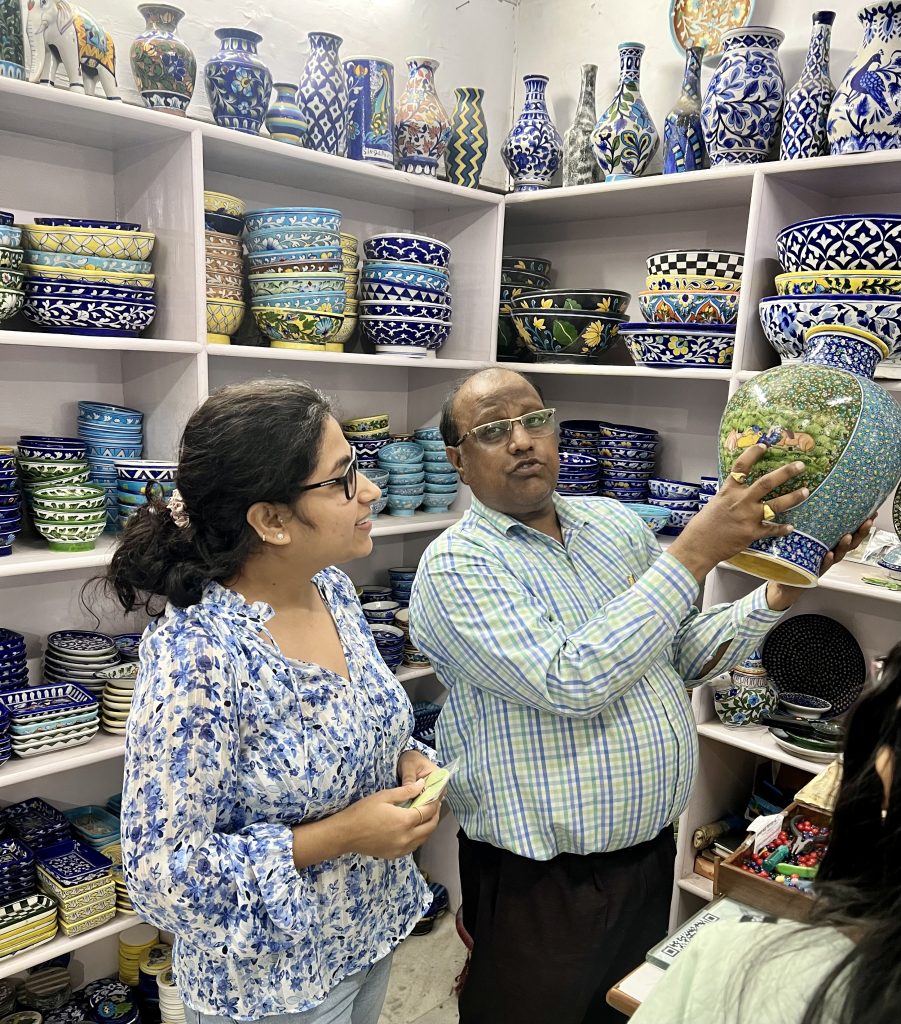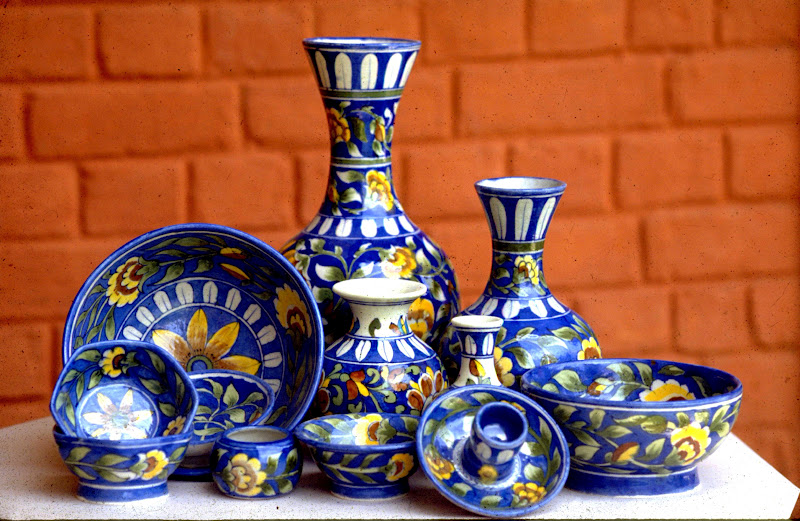The traditional craft of blue pottery has its roots in China, Persia (modern-day Iran), and Central Asia, among other places. That is, however, most frequently connected to Jaipur in Rajasthan, India. The characteristic blue colouration of blue pottery is what gives it its name. Applying blue oxide glaze over a white substrate is a unique technique to obtain the blue tint. The ceramic is then decorated with designs using various methods, such as stencilling, block printing, or hand painting.
The absence of clay in blue pottery is one of its distinguishing characteristics. A unique combination of quartz stone powder, powdered glass, borax, gum, and Multani Mitti (Fuller’s earth) makes blue pottery instead of clay. The unique translucent appearance of blue pottery is a result of this mixture. Vases, bowls, plates, tiles, and decorative pieces are only a few examples of the diverse goods made of blue pottery. Their rich cultural background is reflected in the exquisite floral and geometric motifs that cover them.
In addition to its aesthetic value, blue pottery has become increasingly popular due to its environmentally responsible manufacturing process. Since it doesn’t contain clay, necessitating fire at lower temperatures and using more energy, it is considered an ecologically beneficial pottery type. Blue pottery pieces are valued as decorative art pieces, frequently sought after by collectors and tourists, and utilised as helpful household goods. They are evidence of the artistic heritage and expert craftsmanship of the areas in which they are made.

The art of Blue Pottery is a true marvel, born from a marriage of tradition and innovation. Its enchanting name stems from the mesmerising hue of cobalt blue dye that graces its surface, capturing the eye and stirring the soul. This art form is unlike any other, for it eschews the use of clay, instead utilising a unique blend of quartz stone powder, powdered glass, Multani Mitti (Fuller’s earth), borax, gum, and water. The resulting material is a delicate and refined substance, yielding pottery of breathtaking beauty and exquisite craftsmanship. During the reign of Sawai Ram Singh II, Blue Pottery found its way to Jaipur, taking root in the hearts and minds of the people. Since then, it has become a treasured part of the city’s rich cultural heritage, delighting visitors with its intricate patterns and captivating colours.
The Dhundhar region of Rajasthan is rich in semi-precious stones (quartz), one of the main items required in the craft and hence, Jaipur became the hub of Blue Pottery. Making identical replicas of any product is difficult as each piece is hand-painted. It takes at least 15 to 20 days to finish the products as it is time-consuming, tedious and expensive. The other big centre, located only next to Jaipur and associated with blue pottery craft, is Kot Jewar, about 60 km from Jaipur.
The raw materials, like quartz stone powder, powdered glass, Multani Mitti (Fuller’s earth), borax, gum and water, are ground in a traditional Chakki grinder. Then, they are weighed and fixed in proportions. Then, they are blended and kneaded with water and are available in dough, which is kept in a plastic bag to retain moisture. The dough is then flattened with a traditional tool known as thepai. The dough is set into open moulds, trimming the edges with a knife. Then, these moulds are filled with ashes so that deformation does not take place, and once it is set, the ash is removed, and the mould is lifted. The sides are smoothened manually, and it is polished with the help of sandpaper.
Only the neck and lips are shaped on the wheel, and the rest of the decoration and ornamentation is done with the help of a brush made from squirrels’ hair. All the items made by this technique are semi-transparent and are mainly designed by intertwined flowing patterns scattered with motifs of birds and animals. A wide range of products are obtained by this method – urns, pots, vases, tea cups, plates, glasses, jugs, ashtrays and napkin rings. The most common colours used are blue, derived from cobalt oxide, green from chromium oxide, turquoise from copper sulphate, yellow from cadmium oxide, and brown from iron oxide.
To create oxide colours, coloured stones are ground using a stone grinder called a silbatta. Gum is added to this mixture to bind the colours together. The process of designing and painting is followed by glazing. The glaze ingredients are placed inside the kiln and dripped out into cold water from the bottom of the kiln. The glaze material is collected and turned into a fine powder in molten lumps. This powder is then applied to the product, ready to be fired in the kiln. The kiln is fired with the help of either wood or coal and maintained at a continuous temperature of 800 degrees Celsius for approximately 8 hours. Afterwards, the kiln is allowed to cool for at least three days before removing the finished products.

Anil Doraya, a National Award-winning artist and the owner of Jaipur Blue Pottery Art Centre, explains how Blue Pottery took an exciting route in finding its home in Jaipur. Ram Singh II attended a kite flying session and watched as his kite masters were engaged in battle with two brothers named Churaman and Kaluram from Achnera (Agra). He was intrigued when the ruler saw that the brothers managed to bring down the royal kites every time. He asked the brothers their secret. Sawai Ram Singh II was impressed and invited the brothers to stay in Jaipur to teach this unique form of glazed pottery at his new art school. Both were appointed heads of the department in the Museum and School of Arts. For the next 100 years, this department was solely under the control of their family. They told him they were potters by profession and had coated their stings with the same blue-green glass they used for their pots.
This splendid craft was kept alive and promoted by Highness Gayatri Devi. It experienced a sudden boost in the 1960s when the internationally acclaimed artist Kripal Singh Shekhawat took an interest and joined the field of blue pottery. The impenetrable and unique quality of not developing cracks makes it an appropriate choice for everyday use. The craft is mainly performed by the Kharwal, Kumbhar, Bahairwa, and Nat castes. Kharawal and Khambar are the primary producers of blue pottery.
Jaipur blue pottery is a unique and beautiful art form with a rich history and enduring legacy. Its distinctive blue colour, intricate designs, and durability make it a popular choice for decorative items and a cherished piece of Rajasthan’s cultural heritage. Through the efforts of artisans and supporters, the art of Jaipur blue pottery continues to thrive and will undoubtedly continue for many years.

Contributor





